15 Climate Change and the Anthropocene
We will conclude our discussion of the interplay of biology and geology on Earth with an examination of what is almost certainly the most rapid change in the composition of the atmosphere in history: the emission of carbon dioxide and other greenhouse gases by human activity. Viewing this process and its effects through the lens of the Earth system—the web of interactions responsible for the Earth as we know it—helps us to understand these changes and their possible consequences.
Learning Objectives
By the end of this chapter, you will be able to:
- describe the components of the Earth system and give examples of how they interact
- explain the evidence for present day human-caused climate change
- discuss the impacts of climate change
- describe some of the feedback loops that can amplify global warming
- discuss the solutions to climate change
- place the current changes in geological context
The Earth System
Earth can be characterized in terms of its “spheres.” The atmosphere is the envelope of gas surrounding the planet. The hydrosphere is the water on the planet, whether in oceans, rivers, glaciers, or the ground. The biosphere comprises living organisms. The lithosphere is the rocky outer shell of the planet.
Components of these spheres interact constantly, with processes occurring in one sphere having an impact in other spheres. Cycles such as the water cycle or the carbon cycle constantly move matter and energy between spheres. Taking an Earth-system approach—looking at how the spheres are connected—is a way to account for the web of interactions responsible for the “big picture” of the Earth that we know.
We’ll consider an example that illustrates the complexities of the Earth system. Until about 40 million years ago, South America and Antarctica were connected by a land bridge. Prior to this time, the passage between South American and Antarctica did not exist (top left map), and neither did the Antarctic ice cap. The arm of land connecting South America and Antarctica allowed warm ocean currents (red arrows) to carry heat from the equator to Antarctica. When the gap opened up, a new cold-water current formed (blue arrows) that blocked warm water from reaching Antarctica. Without the warm current, Antarctica froze over.
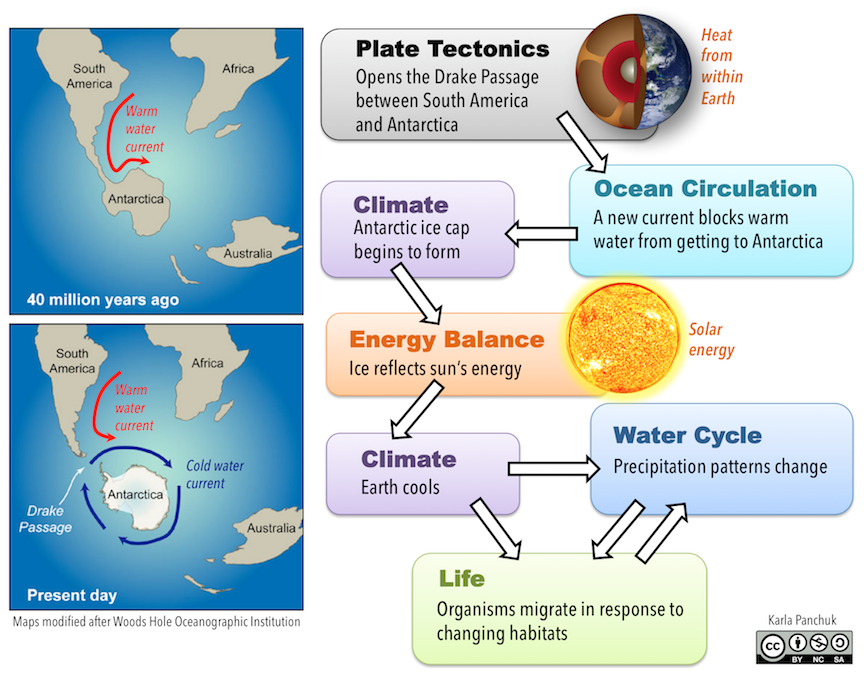
There were many interconnecting processes within the Earth-system (Figure 1, right) that drove glaciation in Antarctica. First, heat energy within Earth drove plate tectonics (lithosphere), making it possible for South America to separate from Antarctica. This impacted ocean currents (hydrosphere), and ultimately how water was stored on Antarctica (hydrosphere) by changing the climate of Antarctica.
In the Earth system, nothing happens in isolation. The change in the climate of Antarctica had a global impact. The ice cap on Antarctica increased Earth’s albedo, the reflectiveness of Earth’s surface. The more reflective Earth’s surface, the more of the sun’s light is reflected back into space without heating Earth. This caused even more ice to form, and cooled the planet as a whole.
When Earth cools, the change in temperature has a cascade of effects including changing precipitation patterns (hydrosphere), and changing the characteristics of habitats (biosphere). When habitats cool, organisms needing more warmth will migrate closer to the equator. This is true of plants as well as other forms of life.
Ice is not the only type of land cover that affects albedo—forests do as well. Forests also increase local atmospheric moisture levels through transpiration, when they release water vapour into the atmosphere. Local temperature and moisture differences also affect rainfall patterns on top of larger-scale changes resulting from cooling.
The chain of events in summarized in Figure 1 is only a broad overview of all of the consequences of opening a gap between South America and Antarctica. For example, it does not include the effects of what a change in the types of plants in a location does to local weathering and erosion. Trees can accelerate weathering, releasing more nutrients from rocks into runoff, which can affect algae blooms in water bodies, which in turn reduces oxygen levels in the water, which affects organisms living in the water that rely on oxygen.
Trees growing along a river can also slow the rate of erosion, reducing the amount of sediment in the river, and ultimately the rate of development of a delta at the river’s mouth. Deltas undergo subsidence as accumulated sediments are compressed, so if the sediment supply is reduced, parts of the delta may become flooded, changing the extent of wetlands. Wetlands with waters depleted in oxygen can prevent plant material from decaying and releasing their carbon back into the carbon cycle as carbon dioxide. Changing atmospheric carbon dioxide levels alters the way energy moves through Earth’s atmosphere, and affects Earth’s surface temperatures.
The short version of why it’s important to look at Earth as a system is that everything is connected, so that a change in one part of the system can ripple through the rest of the system and have effects well beyond any one location or time.
Feedbacks Amplify or Diminish Earth-System Change
The web of interactions in the Earth system is complex, but there is yet another level of complication. Sometimes a change in the Earth system can trigger other changes that have the effect of amplifying the original change, or diminishing it. Recall that the series of interactions that amplify or diminish a change are called feedbacks. A feedback that amplifies change is called a positive feedback. A feedback that diminishes the size of a change is called a negative feedback.
In the events related to the glaciation of Antarctica, the formation of ice is an example of a positive feedback. Ice formation was caused by cooling, but it triggered even more cooling by reflecting sunlight away from Earth’s surface. This is called ice albedo feedback. An example of a negative feedback is plant growth. Plants need CO2 to make food, so as long as the plants have enough nutrients and water, and temperatures are still suitable, increasing CO2 in the atmosphere could increase plant growth. Plant growth would draw down atmospheric CO2, so that there would be less warming than would otherwise be expected from the initial rise in atmospheric CO2 levels.
Misconceptions About Feedbacks
There are two common misconceptions about feedbacks. One misconception is that positive feedbacks result in changes that are good, and negative feedbacks result in changes that are bad. In fact, whether a feedback is positive or negative is unrelated to whether or not the change would be considered a good thing. For example, if a feedback accelerates warming and makes an ecosystems uninhabitable for animals that used to live there, it would still be a positive feedback even though it had a negative impact on the animals in that ecosystem. A feedback that slowed the rate of warming and gave the animals time to adapt would still be considered a negative feedback even though it helped the animals to survive.
Another misconception is that a positive feedback always results in some value increasing (e.g., a rise in temperature), and a negative feedback results in a decrease in that value. Positive feedbacks can cause a value to decrease (e.g., as ice forms more sunlight is reflected, leading to decreased temperatures), and negative feedbacks can cause a value to increase. What matters is whether the initial change is amplified or reduced, not which way the numbers are changing.
Feedbacks and Instability in the Earth System
The potential for sudden extreme changes in the Earth system depends on what feedbacks are available. At times when Earth’s climate was much warmer than today, no glaciers were present. When the climate is much cooler, a relatively small decrease in temperature could be enough to start the formation of ice and trigger the ice albedo feedback. However, if the climate is much warmer, the same decrease in temperature would not cool Earth enough to trigger the ice albedo feedback, and further climate cooling would be avoided. The reverse is also true- if warming occurs in a climate that is cold enough for glaciers to form, some of that ice might melt, reducing the albedo of Earth’s surface, and permitting even more warming. On the other hand, if the climate is already too warm for ice to exist, a small amount of warming won’t be amplified in the same way.
The albedo effect is not the only feedback that can make cooler climates less stable. Melting of permafrost (sediment that remains frozen year round) can also have an impact. Frozen soil contains trapped organic matter that is converted by micro-organisms to CO2 and methane (CH4) when the soil thaws. Both these gases contribute to warming when they accumulate in the atmosphere. Additional warming can cause even more permafrost to melt, permitting even more activity by micro-organisms, and releasing more CO2 and CH4.
Either of these feedbacks is enough on their own to accelerate climate change, but when they are both present together, the effect is even stronger. What this means is that the conditions in the Earth system before a change happens—called the initial conditions—play an important role in determining the impact of any changes that occur. A change that would have little impact under one set of initial conditions could have far reaching effects under another. Thinking of Earth as a system is a way to factor in the initial conditions. Otherwise we would be very puzzled why a small rise in global temperatures at one time in Earth history could have almost no discernible effect, but the same rise in temperatures at another time could lead to profound change.
Anthropogenic Climate Change
Anthropogenic change in the Earth system is change caused by humans. Many discussions of anthropogenic climate change place the start of human impacts on the Earth system at the beginning of the industrial era, in the mid 18th century. The industrial era was when humans began to use fossil fuels—at the time, mostly coal—on a much larger scale than before to do things like run manufacturing machinery and trains. Fossil fuels are those derived largely from plant material that grew, died, and was partially preserved at various times throughout Earth history. The plants removed CO2 from the atmosphere when they were alive, and stored it in organic compounds in their tissues. The materials accumulated over hundreds of millions of years in settings like swampy forests, shallow seas, and deltas. When fossil fuels are burned, the stored carbon is released back into the atmosphere as CO2.
The Carbon-Isotope Fingerprints of Fossil Fuel
Carbon isotopes provide insights into the extent to which fossil fuels have impacted the Earth system, because fossil fuels have a unique carbon-isotope fingerprint that is detectable in the atmosphere and in geological materials.
Stable Carbon Isotopes (12-Carbon and 13-Carbon)
When plants transform CO2 into tissues, the process imparts a unique carbon-isotope signature to the resulting organic matter. Plants preferentially take in CO2 with the isotope 12C over CO2 with isotope 13C. They do so in a consistent way, giving plant tissues a distinctive ratio of 13C to 12C. Fossil fuels are derived from plant materials, and they preserve this isotopic ratio.
For most of the past 1000 years, the atmosphere has had a steady ratio of ratio of 13C to 12C. However, the carbon-isotope composition of organic matter is much lower than that of the atmosphere, so the mixing in of carbon from fossil fuels causes the over-all carbon-isotope composition of the atmosphere to decrease. An analogy for mixing low 13C CO2 into the atmosphere is rapidly adding cold water to a hot bathtub. The faster the cold water is added, the faster the bathwater will cool. The colder the water being added, the faster the bathwater will cool. In this analogy, the atmosphere is the bathtub, and fossil fuels are the water being added. The low 13C value of fossil fuels is like very cold water being added.
As we would expect in this scenario, the carbon isotope composition of the atmosphere takes a sudden downward turn at the same time that humans undertake the Industrial Revolution, and begin burning large quantities of fossil fuels, adding CO2 to the atmosphere at an accelerating rate (Figure 16.32).
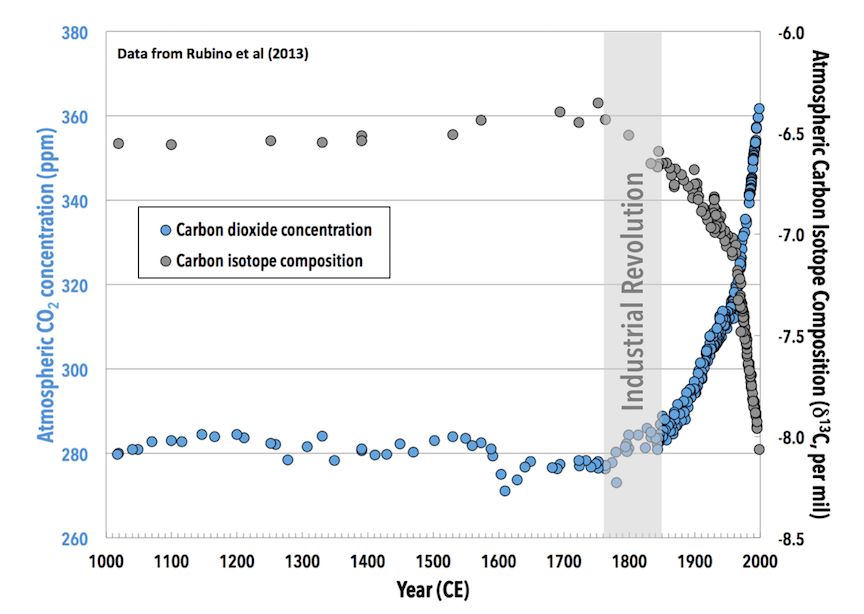
Scientists who study past climates on Earth are familiar with carbon-isotope records like this one, because such records are used to reconstruct major changes in the Earth system through their impact on the carbon cycle. In carbon-isotope records from the distant past, a shift of this magnitude would be enough to catch the attention of a researcher and make them wonder what could have happened.
What is unusual about the drop today in comparison to those observed in the geological record is how rapidly it is happening. It is more common to see such changes happen over millions of years, not hundreds of years. The rate at which atmospheric CO2 13C is dropping is approximately 10 times faster than the carbon-isotope shift during the fastest event ever documented in the geological record, a period 56 million years ago known as the Paleocene-Eocene Thermal Maximum.
Carbon dioxide in the atmosphere mixes into the oceans, where organisms take up carbonate ions to make calcium carbonate shells. The drop has been imprinted in the calcium carbonate of marine organisms, and will remain in the rock record globally, as evidence of human activity. Because of this, and because of many other such markers that are being left in the rock record by human activities (the presence of plastic, for example), some have suggested that it is time to define a new division of geological time, the Anthropocene Epoch. The start of the Anthropocene Epoch would mark the point at which human activities became evident in the geological record.
Signals of Present-Day Earth-System Change
Global Temperature Rise
Since 1880, Earth’s average surface temperature average has trended upward, with most of that warming occurring since 1970. Changes in temperatures compared to a reference period from 1951 to 1980, where the long-term average remained relatively constant, are called temperature anomalies. A temperature anomaly thus represents the difference between the measured temperature and the average value during the reference period.This video of temperature anomalies shows worldwide temperature changes since 1880. The more blue, the cooler; the more yellow and red, the warmer.
Carbon Dioxide
Anthropogenic greenhouse gases, mostly carbon dioxide (CO2), have increased since the Industrial Revolution, when humans dramatically increased burning fossil fuels. These levels are unprecedented in the last 800,000-year Earth history as recorded in geologic sources such as ice cores. Carbon dioxide has increased by 40 percent since 1750, and the rate of increase has been the fastest during the last decade.
Charles Keeling, an oceanographer with Scripps Institution of Oceanography in San Diego, California, was the first person to regularly measure atmospheric CO2. Using his methods, scientists at the Mauna Loa Observatory, Hawai’i, have constantly measured atmospheric CO2 since 1957. NASA regularly publishes these measurements at https://keelingcurve.ucsd.edu. Go there now to see the very latest measurement. Keeling’s measured values have been posted in a curve of increasing values, called the Keeling curve. This curve varies up and down in a regular annual cycle, from summer when the plants in the Northern Hemisphere use CO2 to winter when they are dormant. But the curve shows a steady CO2 increase over the past several decades. This curve increases exponentially, not linearly, showing that the rate of CO2 increase is itself increasing.
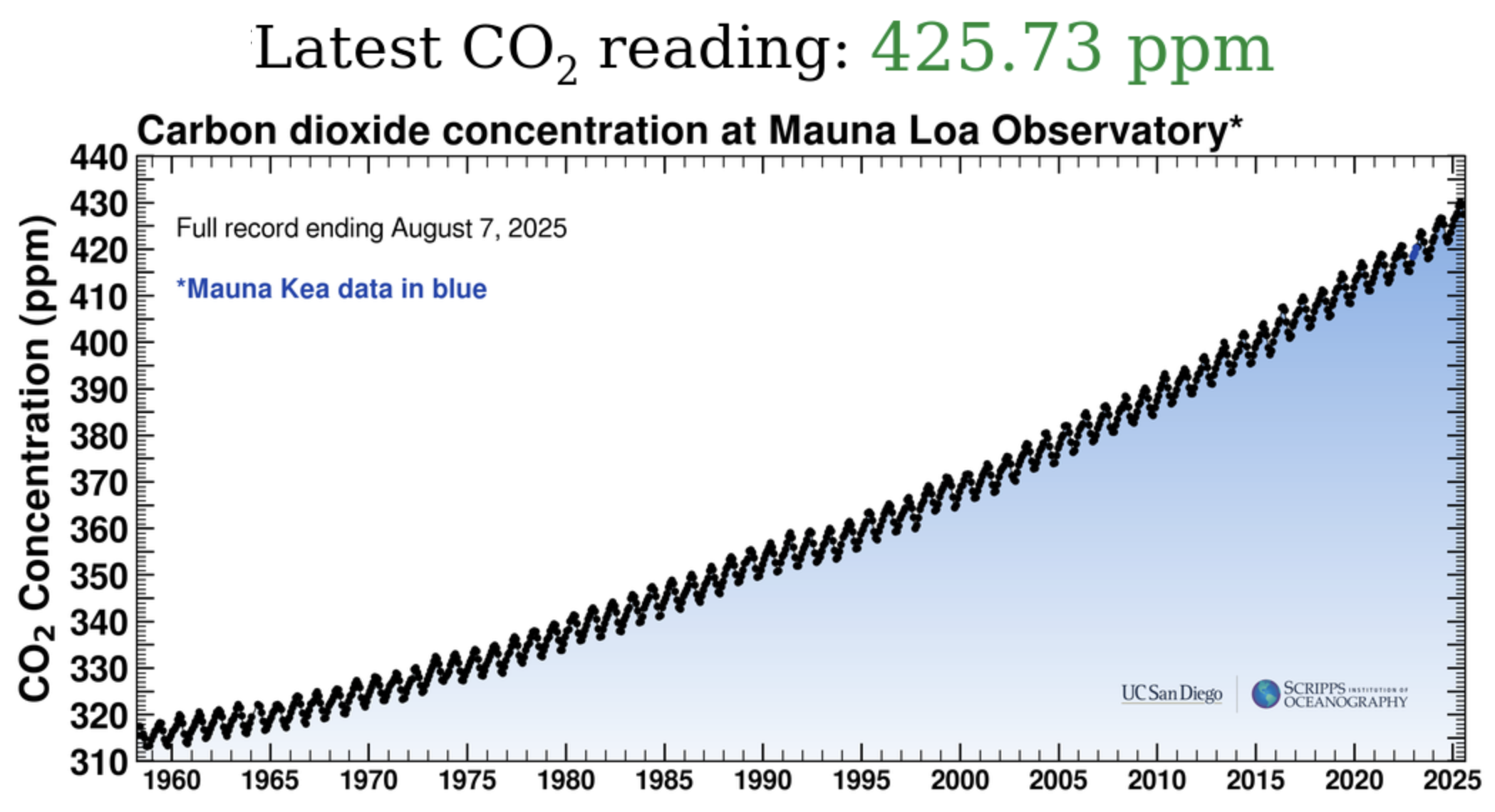
Thanks to measurements from Antarctic ice cores, scientists can measure both temperature and CO2 levels over the past 800,000 years. This record reveals two important things: temperature and CO2 levels track each other closely, as we expect because of the greenhouse effect, and the CO2 concentration today is much higher than at any point in the past 800,000 years. You may also notice from this graph that the recent spike in CO2 level is not accompanied by a similar spike in temperature. This is because it takes time for the Earth system to respond to rapid changes in the atmosphere. In other words, many of the effects of recent CO2 emissions may still be to come.
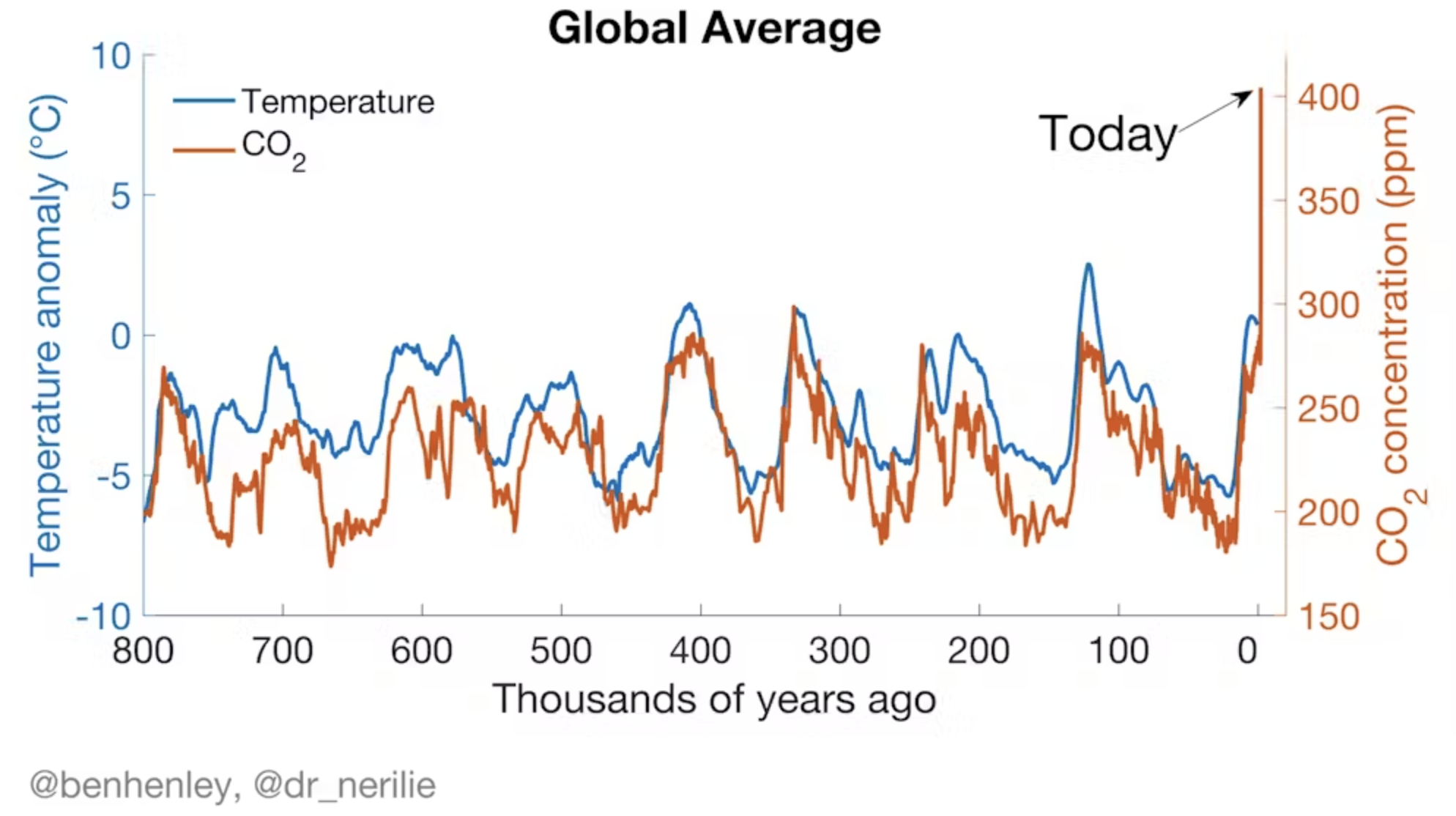
Melting Glaciers and Shrinking Sea Ice
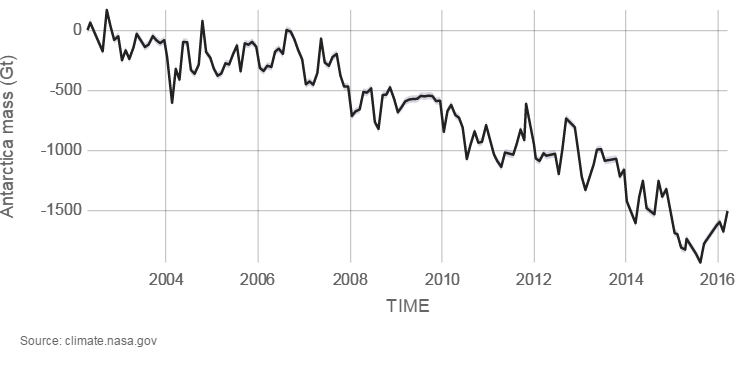
Glaciers are large ice accumulations that exist year-round on the land’s surface. In contrast, icebergs are masses of floating sea ice, although they may have had their origin in glaciers. Alpine glaciers, ice sheets, and sea ice are all melting. The ice-mass loss rate is unprecedented—never observed before—since the 1940s, when quality records for glaciers began.
Before anthropogenic warming, glacial activity was variable with some retreating and some advancing. Now, spring snow cover is decreasing, and sea ice is shrinking. Most sea ice is at the North Pole, which is only occupied by the Arctic Ocean and sea ice. The NOAA animation shows how perennial sea ice has declined from 1987 to 2015. The oldest ice is white, and the youngest, seasonal ice is dark blue. The amount of old ice has declined from 20% in 1985 to 3% in 2015.
Rising Sea Levels
As shown in the video below, scientists have found that global mean sea level has risen about 10 centimeters (4 inches) since 1993. Over the past 140 years, satellites and tide gauges together show that global sea level has risen 21 to 24 centimeters (8 to 9 inches). Recent rates have been unprecedented over the past 2,500-plus years.
According to satellite data, the average rate of change since 1993 has been a rise of approximately 3 mm per year. Part of the rise is due to the expansion of seawater as it warms. Another part of the rise is from water added by melting glaciers and other year-round land-based snow and ice. Note that melting of sea ice—ice already floating in the ocean—does not contribute directly to sea-level rise because the ice is already floating in the ocean.
Based on how much melting has occurred thus far, sea levels are projected to rise to between 0.47 m and 1.3 m above 1880 levels by the year 2100 (Figure 16.36). However, there is some uncertainty about how melting rates will respond to changes in the Earth system that result from climate change, such as changes in currents, or seawater beneath the leading edge of melting ice sheets warming the ice from beneath. With that uncertainty factored in, sea level rise could be as low as 0.33 m above 1880 levels, or more than 2 m higher.
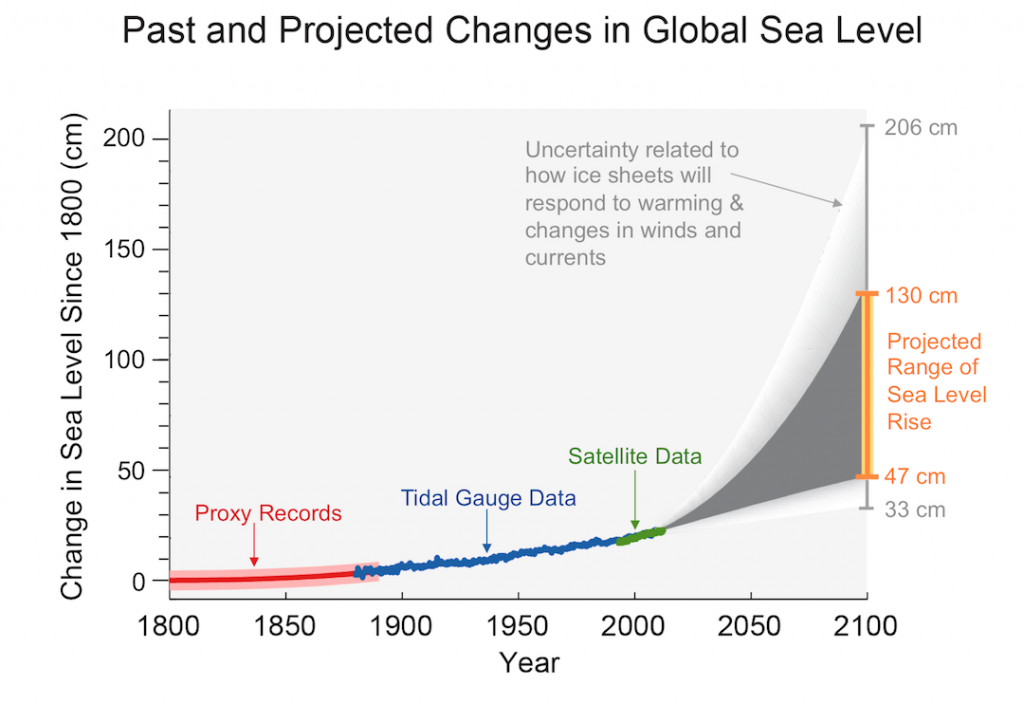
Ocean Acidification
Since 1750, about 40 percent of new anthropogenic carbon dioxide has remained in the atmosphere. The remaining 60 percent gets absorbed by the ocean and vegetation. The ocean has absorbed about 30 percent of that carbon dioxide. When carbon dioxide is absorbed in the ocean, it creates carbonic acid. This makes the ocean more acidic, which then has an impact on marine organisms that secrete calcium carbonate shells. A more acidic ocean is linked to thinning the carbonate shells of some sea snails and small protozoan zooplanktons, and to ocean coral reefs’ declining growth rates. Small animals like protozoan zooplankton are an important component at the base of the marine ecosystem. Combined with warmer temperature and lower oxygen levels, acidification is expected to have severe impacts on marine ecosystems and human-harvested fisheries, possibly affecting our ocean-derived food sources.
Extreme Weather Events
Extreme weather events such as hurricanes, precipitation, and heat waves are increasing and becoming more intense. Since the 1980s, hurricanes, which are generated from warm ocean water, have increased in frequency, intensity, and duration and are likely connected to a warmer climate. Since 1910, average precipitation has increased by 10 percent in the contiguous United States, and much of this increase is associated with heavy precipitation events. However, the distribution is not even, and more precipitation is projected for the Northern United States, while less precipitation is projected for the already dry Southwest. Also, heat waves have increased, and rising temperatures are already affecting crop yields in northern latitudes. Increased heat allows for greater moisture capacity in the atmosphere, increasing the potential for more extreme events.
Climate Change Feedbacks
The many feedback loops embedded in the Earth system have the potential to accelerate the pace of climate change, and so represent one of the most concerning aspects of the problem. A few of these are summarized below.
Thawing Permafrost
Permafrost is soil that remains frozen over long periods. Most of northern Canada has a layer of permafrost that ranges from a few centimetres to hundreds of metres in thickness. The same is true in Alaska, Russia, and Scandinavia. This permafrost is now thawing as global temperatures increase, and the process is exacerbated because the poles are warming more rapidly than the rest of the planet. As permafrost thaws, micro-organisms begin to decompose organic matter within the newly thawed sediments, releasing CO2 and CH4. The amount of these greenhouse gases released by decomposing organic matter could be enough to generate a significant positive feedback, accelerating warming further. In some polar regions, including northern Canada, permafrost also includes methane hydrate, a highly concentrated form of CH4 trapped in solid form. Breakdown of permafrost releases this CH4 as well.
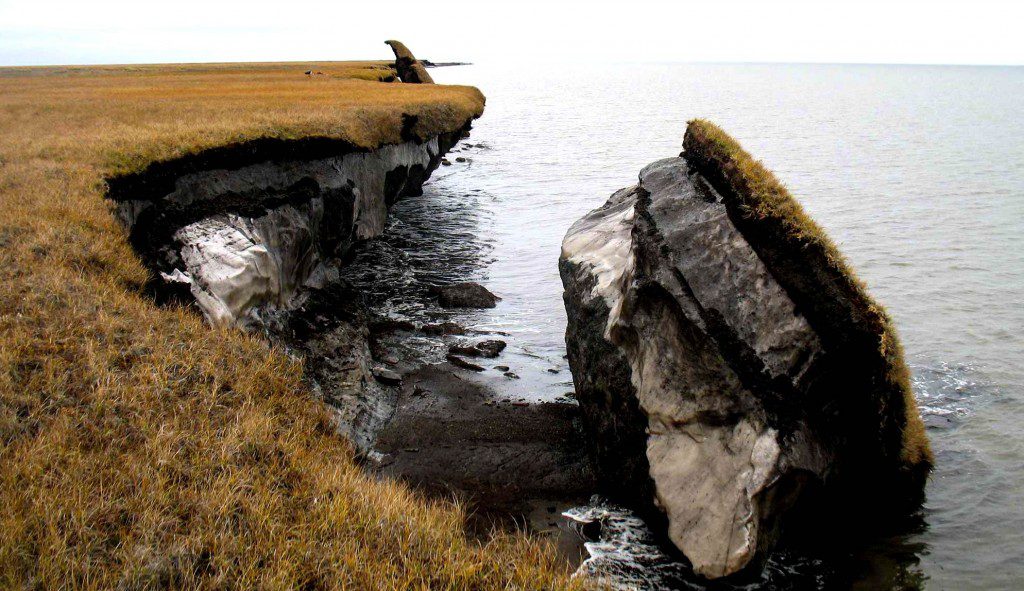
Sea Ice
We have already discussed the loss of sea ice as the planet warms. Because ice reflects a high fraction of sunlight while dark-colored open ocean absorbs it, melting sea ice leads to further warming of the oceans. Warming oceans contribute to the loss of ice, in a positive feedback loop.
Water Vapor
An increase in temperature increases evaporation from the ocean, which increases the amount of water vapor in the atmosphere. Since water vapor is a greenhouse gas, this leads to further warming and more evaporation.
Solutions
Climate change is a difficult problem to solve because our modern society was built upon burning fossil fuels as an energy source. We still depend strongly on fossil fuel energy for everything from driving our cars and washing our laundry to charging our cell phones and heating our homes. In order to stabilize climate, however, we’ll need to move to near-zero carbon emissions in the long run. Thus, the challenge is to decarbonize our economy. The longer we wait with this transformation, the larger the impacts of future climate change will be and the faster future emission reductions will need to be if the goal is to stay within a certain limit of global warming. And because it is a global problem, the whole world, or at least most of it, will need to cooperate to solve it. Moreover, because we’re already committed to further climate change, we need to prepare to adapt to it.
Historically, the increase in carbon emissions was caused by human population growth and an increase in the economy. The increased use of fossil fuel-based energy has lifted many people out of poverty and improved the lives of millions, although many people in the developing world remain in poverty today. Currently the world population is more than eight billion people, and it is expected to continue to increase, at least for the near future. This increase will continue to put more pressures on the Earth system; climate change is just one of them.
Technology
Current global energy production relies heavily on burning fossil fuels. The largest energy sources are oil, coal, and natural gas, all of which are fossil fuels, whereas all non–fossil fuel sources together account for only about 20% of the total. However, in some countries, renewable energy sources have seen a rapid increase in recent years. Germany, for example, has increased renewables’ contribution to total electricity production from 3% in 1990 to 45% in 2020, while its economy has been one of the strongest in Europe. Denmark plans to move to 100% renewable energy by 2050. In the United States, renewables currently account for 10% of total energy consumption and 15% of electricity production, and it is rapidly increasing. In 2016, for example, the US’s solar power capacity doubled.
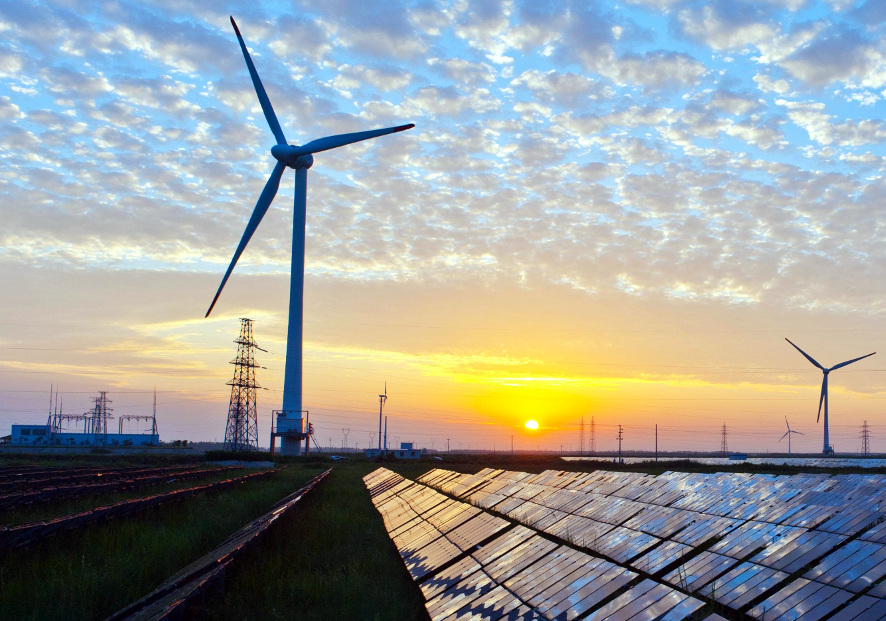
The advantage of renewables is an almost-unlimited potential supply with minimal carbon emissions (some emissions occur during the production and installation of solar panels and wind turbines); in addition, they are not associated with the dangers of nuclear power. Their disadvantage used to be their cost, particularly their high upfront investment cost. Once installed, however, solar panels and wind turbines operate with nearly no maintenance cost since solar energy and wind is free. During the past ten years, the cost for solar panels has decreased by 80%. Thus, if viewed over the lifetime of a system, renewables become competitive with fossil fuels. Other renewable energy sources are geothermal, tide and wave energy, and hydroelectric dams.
Adaptation and Mitigation
While the situation surrounding global climate change is in serious need of our attention, it is important to realize that many scientists, leaders, and concerned citizens are making solutions to climate change part of their life’s work. The two solutions to the problems caused by climate change are mitigation and adaptation, and we will likely need a combination of both in order to prosper in the future. We know that climate change is already occurring, as we can see and feel the effects of it. For this reason, it is essential to also adapt to our changing environment. This means that we must change our behaviors in response to the changing environment around us.
Adaptation strategies will vary greatly by region, depending on the largest specific impacts in that area. For example, in the city of Delhi, India, a dramatic decrease in rainfall is projected over the next century. This city will likely need to implement policies and practices relating to conservation of water, for example, rainwater harvesting, water re-use, and increased irrigation efficiency. Rain-limited cities near oceans, such as Los Angeles, California, may choose to use desalination to provide drinking water to their citizens. Cities with low elevations near oceans may need to implement adaptation strategies for rising sea levels, from seawalls and levees to relocation of citizens. One adaptation strategy gaining use is the creation or conservation of wetlands, which provide natural protection against storm surges and flooding.
In general, a strategy to mitigate climate change is one that reduces the amount of greenhouse gases in the atmosphere or prevents additional emissions. Mitigation strategies attempt to “fix” the problems caused by climate change. Governmental regulations regarding fuel efficiency of vehicles is one example of an institutionalized mitigation strategy already in place in the United States and in many other countries around the world. Unlike some other countries, there are no carbon taxes or charges on burning fossil fuels in the United States. This is another governmental mitigation strategy that has been shown to be effective in many countries, including India, Japan, France, Costa Rica, Canada, and the United Kingdom.
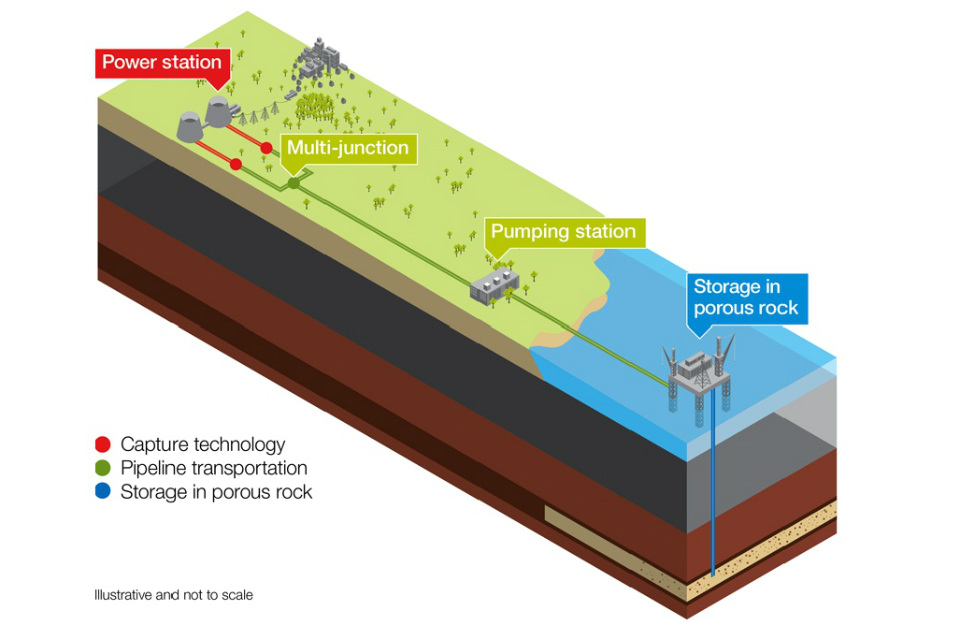
In addition to government measures and incentives, technology can also be harnessed to mitigate climate change. One strategy for this is the use of carbon capture and sequestration (CCS). Through CCS, 80–90% of the CO2 that would have been emitted to the atmosphere from sources such as a coal-fired power plant is instead captured and then stored deep beneath the Earth’s surface. The CO2 is often injected and sequestered hundreds of miles underground into porous rock formations sealed below an impermeable layer, where it is stored permanently.
Scientists are also looking into the use of soils and vegetation for carbon storage potential. Proper management of soil and forest ecosystems has been shown to create additional carbon sinks for atmospheric carbon, reducing the overall atmospheric CO2 burden. Increasing soil carbon further benefits communities by providing better-quality soil for agriculture and cultivation.
Technologies related to alternative energy sources mitigate climate change by providing people with energy not derived from the combustion of fossil fuels. Finally, energy conservation, choosing to walk or bike instead of driving, and disposing of waste properly are simple activities that, when done by large numbers of people, actively mitigate climate change by preventing carbon emissions.
Welcome to the Anthropocene
The geological record provides context for the changes that are now occurring. We see the evidence of previous dramatic changes that have occurred in the Earth system, and the lessons from the five known mass extinctions show that the impact to climate and life is greatest when change is more sudden.
During the middle to late Cretaceous period (about 100 million years ago) the overall temperature of the Earth increased by 5°C. However, this change took place slowly, over the course of millions of years. The warming is thought to have been caused by the steady release of greenhouse gases from volcanic eruptions. Because the rate was so slow, the oceans were able to absorb the greenhouse gases without causing significant acidification. As a result, most life was able to adapt or migrate and survive.
In contrast, during a period 56 million years ago known as the Palocene-Eocene Thermal Maximum (PETM), temperatures rose by 0.025°C every 100 years. In just a few thousand years, the temperature had increased by 5°C. The warming was caused by a combination of volcanoes, methane release from the seafloor, and peat and coal fires. As heating progressed, the permafrost began to thaw, leading to the release of even more greenhouse gases. The oceans began to acidify, leading to the extinction of many organisms living on the seafloor.
Today, humans are exerting a pressure on the Earth system so extreme that it is triggering the start of a new geological epoch: the Anthropocene. Modern-day global warming appears to be occurring at a rate of 1-4°C per 100 years, orders of magnitude faster than the rate during the PETM. The Earth is expected to gain 2-10°C in the next 100 years. There have been times in the history of the Earth when there was as much or more carbon in the atmosphere. There has probably never been a time in the past 4.5 billion years when the rate of change of carbon in the atmosphere has been so rapid. We have pulled coal from the Carboniferous period out of the ground and we are burning it to fuel our industrial revolution. Like it or not, our mark will be left in the geological record of our planet; the first stage of a mass extinction, a rapid decrease in biodiversity, has already started.
The global climate data are unequivocal. We know what to do to mitigate climate change. But this is a problem that we have to solve together. Will humanity answer this call to action?
Climate Change and the Sixth Extinction
Since the industrial revolution, we have had a front-row seat to the sixth major mass extinction. Human activity has led to widespread habitat loss, climate change, pollution, and rising ocean acidity. Vertebrates are dying out at a rate estimate to be a hundred times faster than they would be without human interference. Amphibians that interact with polluted land and water are most impacted, with a current extinction rate tens of thousands times greater than the background extinction rate. Rising temperatures are threatening most species with changes that are now happening on the timescale of generations rather than thousands or millions of years as before.
Key Concepts and Summary
The Earth is a complex system with many interacting spheres and processes. Since the industrial revolution, humans have been burning fossil fuels at an increasing pace, leading to a rise in the amount of carbon dioxide in the atmosphere and an accompanying rise in global temperature. Other consequences include the loss of sea ice, rising sea levels, an increase in extreme weather events, and ocean acidification. Positive feedback loops in the Earth system have the potential to further amplify global warming. Solutions to climate change require a shift away from the use of fossil fuels and other adaptation and mitigation measures. The current rate of changes in temperature and CO2 level is unprecedented in geological history, and the fossil record shows us that rapid changes are linked to mass extinction events.
Review Questions
- What are some of the interlocking components of the Earth system?
- How do we know that the current increase in CO2 levels is due to human activity?
- What are the major impacts of climate change?
- How do feedback loops in the Earth system affect climate change?
- What do we need to do to mitigate the effects of climate change and adapt to its impacts?
This chapter is remixed from Introduction to Earth Science, Second Edition and Physical Geology under a CC BY-NC-SA 4.0 license.

